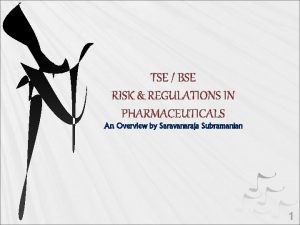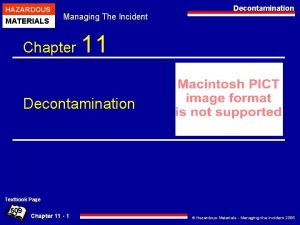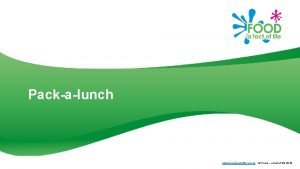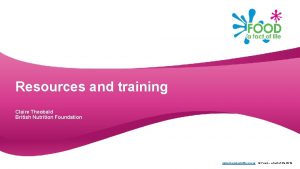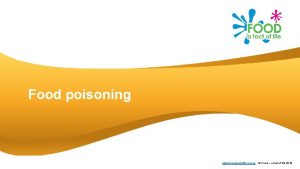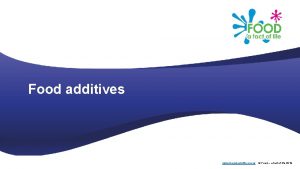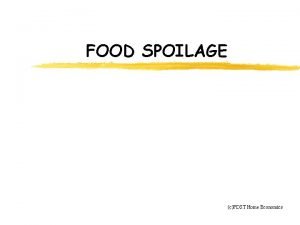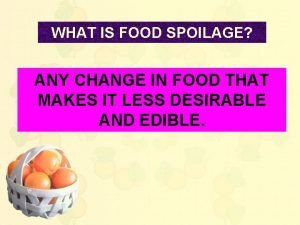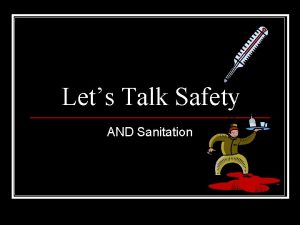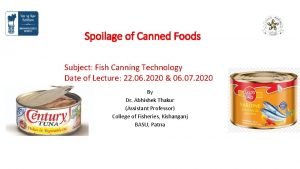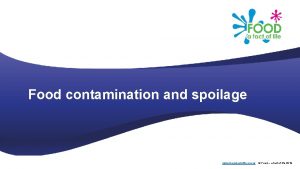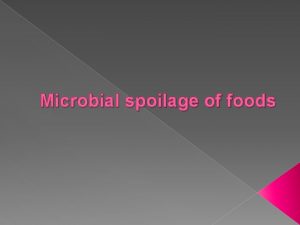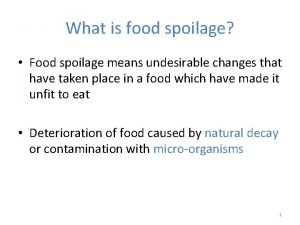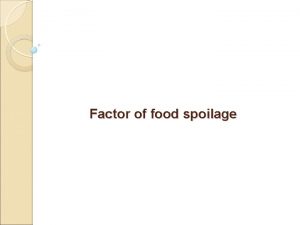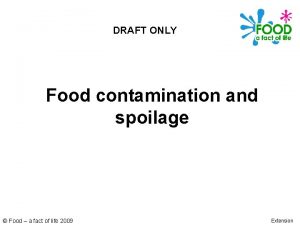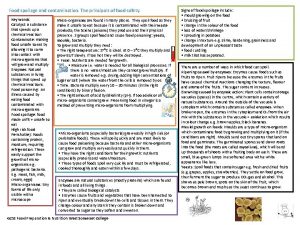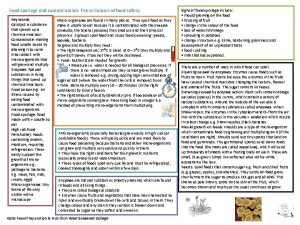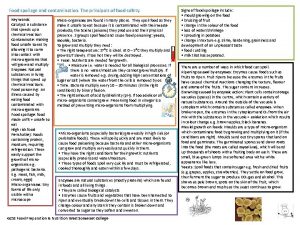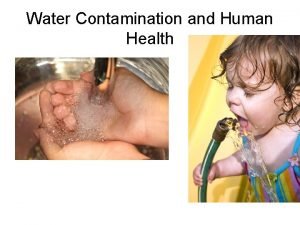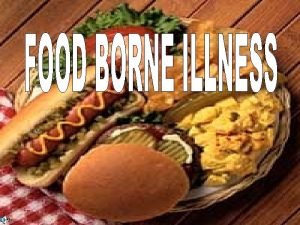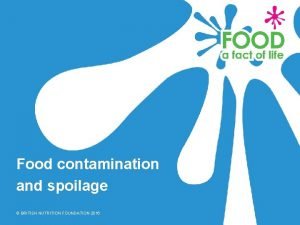Food contamination and spoilage www foodafactoflife org uk

















- Slides: 17

Food contamination and spoilage www. foodafactoflife. org. uk © Food – a fact of life 2019

Food contamination There are three ways which food can be contaminated: • physical; • chemical; • bacterial. www. foodafactoflife. org. uk © Food – a fact of life 2019

Physical contamination can occur in a variety of ways at different stages of food processing and production. Some examples are: • soil from the ground when harvesting; • a bolt from a processing plant when packaging; • a hair from a cook in the kitchen. Care must be taken at each stage to prevent physical contamination. www. foodafactoflife. org. uk © Food – a fact of life 2019

Chemical contamination can occur in a variety of ways at different stages of food processing and production. Some examples are: • chemicals from the farm; • a cleaning product used in the processing plant when packaging; • fly spray used in the kitchen when preparing food. Care must be taken at each stage of food production to prevent chemical contamination. www. foodafactoflife. org. uk © Food – a fact of life 2019

Bacterial contamination As soon as food is harvested, slaughtered or manufactured into a product it starts to change. This is caused by two main processes: • autolysis – self destruction, caused by enzymes present in the food; • microbial spoilage – caused by the growth of bacteria, yeasts and moulds. www. foodafactoflife. org. uk © Food – a fact of life 2019

Desirable food changes Autolysis and micro bacterial changes are sometimes desirable (and are not referred to as spoilage), for example enzymes cause fruit to ripen. Here are some positive micro bacterial changes: Bacteria in yoghurt production. Mould in some cheeses, e. g. Stilton. Yeast in bread production. www. foodafactoflife. org. uk © Food – a fact of life 2019

Autolysis – enzymes Enzymes are chemicals that are found in food. These chemicals have important uses in food. They can cause food to deteriorate in three main ways: • ripening – this will continue until the food becomes inedible, e. g. banana ripening; • browning – enzymes can react with air causing the skin of certain foods, e. g. potatoes and apples discolouring; • oxidation – loss of certain nutrients, such as vitamins A, C and thiamin from food, e. g. over boiling of green vegetables. www. foodafactoflife. org. uk © Food – a fact of life 2019

Microbial spoilage – bacteria These are single celled micro-organisms (they cannot be seen by the naked eye) which are present naturally in the environment. There are many different kinds, some are useful, e. g. in the production of yogurt, and some harmful. The presence of bacteria in food can lead to digestive upset. Some bacteria produce toxins which can lead to this also. Bacillus cereous produces spores – rice should be cooled quickly to prevent multiplication Spores can also be produced by some bacteria leading to toxins being produced. www. foodafactoflife. org. uk © Food – a fact of life 2019

Microbial spoilage – yeast Yeasts are single celled fungi which can reproduce by ‘budding’. This means that a small offshoot or bud separates from the parent yeast cell. Yeasts can also form spores which can travel through the air. These are easily killed by heating to 100ºC. In warm, moist conditions in the presence of sugar, yeasts will cause foods like fruit to ferment producing alcohol and carbon dioxide gas. Yeast is used in the production of bread and wine. www. foodafactoflife. org. uk © Food – a fact of life 2019

Microbial spoilage – mould Moulds are fungi which grow as filaments in food. They reproduce by producing spores in fruiting bodies which can be seen on the surface of foods. These fruiting bodies sometimes look like round furry blue-coloured growths, e. g. mould on bread. Some moulds can be seen by the naked eye, e. g. on bread. www. foodafactoflife. org. uk © Food – a fact of life 2019

Conditions for bacterial growth Micro-organisms need conditions to survive and reproduce these can include: • temperature; • moisture; • food; • time; • oxygen; • p. H level. www. foodafactoflife. org. uk © Food – a fact of life 2019

Conditions for bacterial growth Temperature Bacteria need warm conditions to grown and multiply. The ideal temperature for bacterial growth is 30ºC – 37ºC. Some bacteria can still grow at 10ºC and 60ºC. Most bacteria are destroyed at temperatures above 63 ºC. Bacterial growth danger zone in 5ºC - 63ºC. At very cold temperatures, bacteria become dormant – they do not die, but they cannot grow or multiply. www. foodafactoflife. org. uk © Food – a fact of life 2019

Temperature 100ºC Water boils 75ºC Core temperature of cooked/reheated food (82ºC in Scotland) 5ºC - 63ºC danger zone for rapid growth of micro-organisms 37ºC – optimum temperature for bacterial growth 1ºC - 4ºC temperature of fridge (good practice) Below 8ºC temperature of fridge (legal) 0ºC Freezing point of water -18ºC temperature of freezer www. foodafactoflife. org. uk © Food – a fact of life 2019

Conditions for bacterial growth Moisture Where there is no moisture bacteria cannot grow. However, bacteria and moulds can both produce spores which can survive until water is added to the food. Food Bacteria need a source of food to grow and multiply, these food usually contain large amounts of water and nutrients. Food where bacteria rapidly multiple in are called high risk foods. Time One bacterium can divide into two every 10 -20 minutes. www. foodafactoflife. org. uk © Food – a fact of life 2019

Conditions for bacterial growth Oxygen Some bacteria need oxygen to grow and multiply. These are called aerobic bacteria. Other bacteria grow well when there is no oxygen present, these are known as anaerobic bacteria. p. H level An acidic or alkaline environment can promote or inhibit microbial growth. Most bacteria prefer a neutral p. H (6. 6 – 7. 5). Moulds and yeasts can survive at p. H levels of 1 -1/5 (very acidic), food spoilage usually occurs by yeast and moulds. www. foodafactoflife. org. uk © Food – a fact of life 2019

High risk foods include: • meat, meat products and poultry; • milk and dairy products; • eggs – uncooked and lightly cooked; • shellfish and seafood; • prepared salads and vegetables; • cooked rice and pasta Lion mark hen eggs can now be eaten raw or lightly cooked. Although people who have a severely weakened immune system and who are on a medically supervised diet prescribed by health professionals should cook all eggs thoroughly, even eggs that have the Red Lion stamp. NHS advice www. foodafactoflife. org. uk © Food – a fact of life 2019

Quiz - Kahoot • Use the link below to enter the quiz https: //kahoot. it/challenge/05593031? challenge-id=b 45 e 81 f 4 -4 eea -41 aa-ab 42 -b 9 de 121 de 771_1591531763641 • Pin Number is 05593031 • Record your score in your booklet. www. foodafactoflife. org. uk © Food – a fact of life 2019
 Tse bse meaning
Tse bse meaning 4 types of decontamination hazmat
4 types of decontamination hazmat Www.foodafactoflife.org.uk
Www.foodafactoflife.org.uk Claire theobald
Claire theobald Foodafactoflife
Foodafactoflife Food a fact of life
Food a fact of life Foodafactoflife
Foodafactoflife Www.foodafactoflife.org.uk
Www.foodafactoflife.org.uk Www.foodafactoflife.org.uk
Www.foodafactoflife.org.uk Www.foodafactoflife.org.uk
Www.foodafactoflife.org.uk Foodafactoflife
Foodafactoflife Food contamination monitoring system
Food contamination monitoring system Causes of food deterioration
Causes of food deterioration Four f's of food contamination
Four f's of food contamination Define food spoilage
Define food spoilage Food spoilage signs
Food spoilage signs Food spoilage signs
Food spoilage signs Chemical spoilage of canned food
Chemical spoilage of canned food
